Call of the Wild: The Awe-Inspiring Osprey

At Cumberland Island’s Dungeness Mansion, a bird’s shrill cry pierces the silence. The ospreys have returned to their nest atop the ruins’ lofty chimney. Maybe you have heard ospreys’ calls in your neighborhood, too. Let us learn about these majestic birds, their superior hunting skills, and their fight for survival below.
All About the Osprey
Ospreys are large birds of prey, measuring around 21 to 24 inches in length with a wingspan of up to 6 feet. Their plumage is distinct: dark brown upperparts contrast with white underparts and a white head, with a dark eye stripe that extends to the back of the head. This eye stripe helps reduce glare from the sun when the birds scan the water for fish.
Ospreys are unique among raptors in that they eat fish almost exclusively; it makes up over 99 percent of their diet. They are expert hunters and can spot fish from heights of over 100 feet with their acute eyesight. To hunt, they dive feet-first to snatch a fish below the surface with their powerful talons. Upon catching a fish, they often reposition it head-first to reduce wind resistance during flight.
Ospreys’ talons and feet are among their most fascinating features. Unlike most raptors, ospreys have a reversible outer toe, allowing them to grasp slippery fish with two toes in front and two behind. Their feet are also equipped with sharp spicules—tiny, rough projections—which help them grip their prey securely.

Ospreys are found on every continent except Antarctica, but Southeast Georgia’s extensive marshes, rivers, and coastal habitats offer them ideal environments. These birds are migratory and can fly thousands of miles between breeding and wintering grounds. For example, North American ospreys often winter as far south as Central and South America.
Nestling in the Nest
Ospreys are loyal to their nesting sites. They build large nests, usually on high, open platforms near water, such as trees, cliffs, and even man-made structures like utility poles and nesting platforms. They make these nests of sticks and line them with softer materials, and they can reuse and add to them each year, sometimes growing them to more than 10 feet wide.
Both male and female ospreys participate in nest building, though the female does most of the incubation. Ospreys are attentive parents; while the female guards and feeds the young. the male provides fish. Typically, a pair raises two to four chicks each season.
In many places, osprey nests have become local attractions, even being featured on live-streaming webcams where viewers can follow the nesting season in real time. One notable project is the “Landings Bird Cam,” which has documented osprey nesting activity on Skidaway Island near Savannah. This live stream has allowed bird enthusiasts to observe osprey behavior and chick development in real-time. It has been instrumental in raising awareness about osprey conservation.
Ospreys on the Upswing
The osprey’s story is one of remarkable recovery. During the mid-twentieth century, osprey populations plummeted due to widespread use of the pesticide DDT, which caused eggshell thinning and reproductive failure. After DDT’s banning in many countries and the ramping up of conservation efforts—including nest platform installations and habitat protection—ospreys’ numbers began to rebound.
More locally, in the 1990s the Georgia Department of Natural Resources (DNR) and Georgia Power collaborated to install nesting platforms along the Georgia coast. These platforms provide safe and stable sites for ospreys to build their nests away from the hazards of power lines and other manmade structures. Today, ospreys are considered a conservation success, particularly in North America and Europe.
While ospreys have made a strong comeback, they still face challenges, as habitat loss and pollution continue to threaten their nesting and fishing areas. Plastic pollution in particular is an issue, since ospreys may inadvertently incorporate plastic waste into their nests, sometimes with harmful consequences. Continued conservation efforts such as protecting nesting areas, reducing water pollution, and educating the public are vital to ensuring ospreys continue to thrive.
At Dungeness, the ospreys’ eggs have recently hatched, and the chicks can be heard screeching from their chimney top. How special that we may witness these elegant and powerful birds’ success story play out at our treasured local landmark.
Come view the Ospreys for yourself on our Cumberland Island Walking Tour: Haunting Ruins and Wild Horses!


